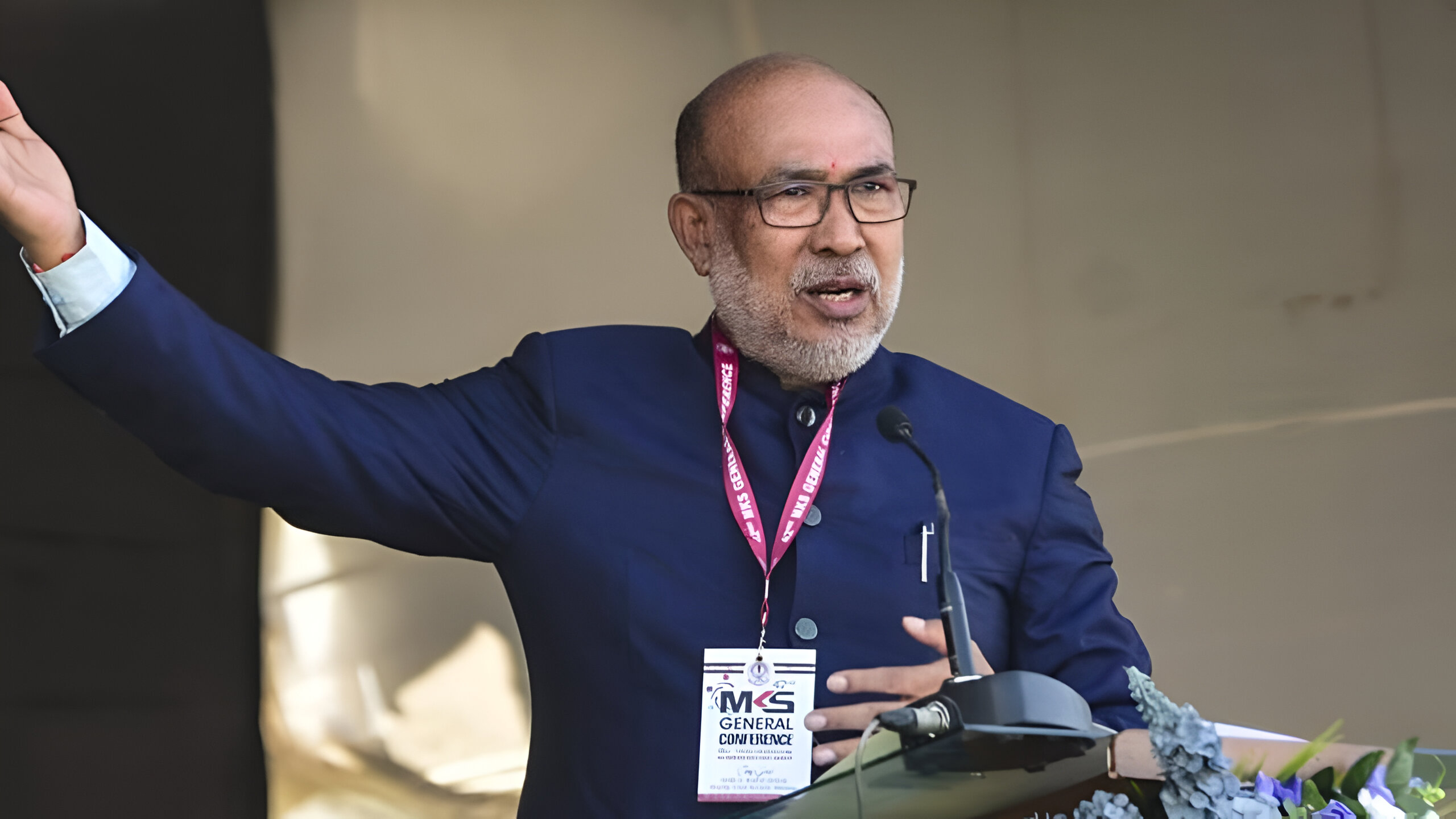Former CM Biren Singh Highlights Manipur’s Road Development Initiatives
Summary
Former Chief Minister Biren Singh recently shed light on the transformative road development initiatives in Manipur. In his address, he highlighted how these projects are not just paving roads but also paving the way for economic growth, improved connectivity, and overall better quality of life in the state. His insights reveal a commitment to bridging historical gaps, fostering development, and ensuring that even remote corners of Manipur are connected to progress.
Long Article
Introduction: A New Era for Manipur’s Roadways
Imagine driving down a newly paved road that winds through lush landscapes, connecting remote villages with bustling urban centers. Picture communities that were once isolated now buzzing with economic activities, their aspirations riding high on the smooth asphalt of progress. This is the vision that former Chief Minister Biren Singh has passionately advocated for. In his recent remarks, he highlighted the monumental strides Manipur is taking in road development initiatives—a transformation that is redefining the region’s infrastructure and igniting hope for a brighter future.
In this article, we’ll dive deep into the various facets of Manipur’s road development, discuss the impact of these initiatives on everyday lives, and explore the broader economic and social benefits that come with enhanced connectivity. So, buckle up as we take you on a journey through Manipur’s evolving landscape, where every road tells a story of resilience, innovation, and progress.
A Vision for Connectivity and Progress
Former CM Biren Singh’s focus on road development isn’t just about constructing new highways; it’s about building lifelines that connect people, markets, and opportunities. Why is this so crucial? Think of the roads as the veins of the state’s body. Just as healthy blood circulation keeps a body alive, efficient road networks sustain the lifeblood of a thriving community—facilitating the flow of goods, services, and ideas.
Biren Singh’s vision goes beyond mere transportation. He sees these projects as catalysts for social change and economic upliftment. For decades, many parts of Manipur struggled with accessibility issues, hindering growth and isolating communities. Now, with robust road networks under development, there’s a renewed sense of optimism that every corner of the state will soon enjoy the benefits of modern infrastructure.
Historical Context: Overcoming Geographic Challenges
Manipur is blessed with breathtaking natural beauty—from rolling hills and dense forests to serene rivers. However, these same features that make it so picturesque also present significant challenges for connectivity. The region’s rugged terrain and remote locations have long been obstacles to development. Imagine trying to navigate a maze where every turn is a hurdle—this was the reality for many communities in Manipur.
Former CM Biren Singh’s roadmap for road development is designed to overcome these geographic challenges. By investing in advanced engineering techniques and sustainable construction practices, Manipur is gradually transforming its natural obstacles into avenues for progress. It’s like turning a rocky path into a smooth expressway, ensuring that the beauty of the land doesn’t become a barrier to its potential.
Key Highlights of the Road Development Initiatives
Let’s break down the major components of these initiatives, which have been carefully crafted to address both immediate needs and long-term aspirations:
1. Expansion of Road Networks
One of the standout features of the initiative is the extensive expansion of road networks across the state. New highways and arterial roads are being constructed, connecting remote villages to major trade centers. This expansion is not just about quantity but also quality—modern, well-maintained roads that ensure safety and reduce travel time.
Imagine a network of roads like the intricate threads of a well-woven tapestry—each thread connecting different parts of the fabric to create a cohesive, strong whole. That’s the vision for Manipur: every village, town, and city will soon be interlinked, fostering unity and shared growth.
2. Upgrading Existing Infrastructure
It’s not enough to build new roads; the state is also focusing on upgrading existing ones. Many of Manipur’s traditional routes, which have served the community for decades, are getting a much-needed makeover. This includes widening narrow roads, resurfacing damaged sections, and implementing advanced traffic management systems.
Upgrading these roads is like giving an old, cherished car a complete restoration—preserving its legacy while equipping it with modern technology. The improved roads will be safer, more efficient, and capable of supporting the growing demands of a modern economy.
3. Emphasis on Sustainability
Environmental concerns are at the forefront of these projects. Manipur’s rich biodiversity and natural heritage are irreplaceable assets. Therefore, the road development initiatives are designed with sustainability in mind. Eco-friendly construction materials, waste management practices, and energy-efficient technologies are being incorporated to minimize environmental impact.
Think of it as building a bridge that not only spans a river but also preserves the river’s natural flow and health. By ensuring that infrastructure projects are sustainable, Manipur is setting an example for responsible development that other regions can follow.
4. Integration of Digital Technologies
In today’s digital age, connectivity isn’t just physical—it’s also virtual. The initiative includes the integration of digital technologies that enhance the management and maintenance of road networks. From real-time traffic monitoring to smart signage and automated maintenance alerts, these technologies ensure that the roads remain safe and efficient.
Imagine having a digital assistant that monitors the condition of the road and alerts the authorities before a minor crack becomes a major issue. This proactive approach to infrastructure management is set to revolutionize the way roads are maintained, ensuring longevity and reliability.
5. Boosting Local Economies
Improved roads are more than just a convenience—they are a powerful economic driver. The enhanced connectivity is expected to stimulate trade, attract investments, and create job opportunities. Local businesses, especially those in remote areas, will benefit from easier access to markets and resources. This means more growth, more prosperity, and a better quality of life for the people of Manipur.
It’s like opening a new highway that leads to a thriving marketplace—suddenly, local products can reach national and international buyers, boosting the entire economy. The road development initiatives are set to turn Manipur into a hub of economic activity, where progress is measured not just in kilometers paved, but in lives transformed.
Transformative Impact on Daily Life
For the people of Manipur, the effects of these initiatives will be felt in countless ways. Let’s explore how improved road infrastructure is set to enhance everyday life:
Enhanced Mobility and Reduced Travel Time
One of the most immediate benefits of improved roads is the drastic reduction in travel time. Long, arduous journeys that once took hours can now be completed in a fraction of the time. This increased mobility means that people can access essential services—like healthcare and education—more efficiently, and local businesses can transport their goods with greater ease.
Imagine being able to visit a loved one or get to work without the stress of navigating rough, unpredictable roads. The improved infrastructure is like a breath of fresh air, simplifying daily commutes and opening up new opportunities for personal and professional growth.
Improved Safety and Reduced Accidents
Modern road construction standards include features designed to enhance safety—better lighting, clear signage, pedestrian pathways, and well-maintained surfaces all contribute to reducing the risk of accidents. For a region where road safety has often been a concern, these improvements are a significant step forward.
It’s like moving from an old, creaky bridge to a state-of-the-art, secure overpass—every journey becomes safer, instilling confidence in the community. The focus on safety not only protects lives but also fosters a sense of security that is essential for long-term development.
Economic Upliftment Through Better Connectivity
As roads improve, so does the ease of doing business. Farmers can transport their produce to larger markets, local artisans can showcase their crafts to a broader audience, and entrepreneurs can explore new business ventures. This increased economic activity is expected to have a ripple effect throughout the region, leading to overall economic upliftment.
Think of it as laying the tracks for a high-speed train—when the route is clear and efficient, the entire system runs smoothly, benefiting everyone. The connectivity provided by these roads will help break down the barriers that have long hindered economic progress in Manipur.
Challenges on the Road to Progress
No transformative project is without its challenges. While the initiatives have been met with enthusiasm, there are hurdles that need careful navigation:
Geographical and Climatic Hurdles
Manipur’s diverse terrain—characterized by hills, valleys, and unpredictable weather patterns—poses significant challenges for road construction. Engineers and planners must constantly adapt to these conditions, using innovative techniques and resilient materials to ensure that the roads withstand natural adversities.
It’s a bit like trying to build a sandcastle on a windy beach—every element must be carefully considered to ensure stability. Despite these challenges, the commitment to overcoming them speaks volumes about the determination to see the project through.
Funding and Resource Allocation
Large-scale infrastructure projects require substantial investments, and ensuring adequate funding can be a hurdle. The government, along with private partners, must navigate budget constraints and secure the necessary resources to bring the vision to life. However, with the economic benefits that these projects promise, many see this as an investment in the region’s future rather than a mere expense.
Imagine planting a seed that takes time to grow but eventually bears fruit for generations—a well-funded infrastructure project is just that, nurturing the potential of Manipur for long-term prosperity.
Balancing Modernization with Cultural Preservation
While modernization is essential, it is equally important to preserve the unique cultural heritage of Manipur. There’s a delicate balance between paving the way for progress and maintaining the traditions that define the region. Planners are working closely with local communities to ensure that development projects respect cultural landmarks and historical sites.
It’s like renovating an old house—while you update the facilities, you preserve the character that makes it unique. This balance ensures that progress is not achieved at the expense of cultural identity.
Former CM Biren Singh’s Vision: A Catalyst for Change
Former CM Biren Singh’s emphasis on road development is a testament to his forward-thinking leadership. His vision has always been about more than just physical infrastructure; it’s about creating an environment where every citizen can thrive. By focusing on roads, he is addressing a fundamental need—connectivity.
In his speeches and interviews, Biren Singh has often painted a picture of a Manipur where distance is no longer a barrier to progress. His belief in the power of connectivity resonates deeply with the people, inspiring hope and a collective drive towards a better tomorrow. He has repeatedly highlighted how improved roads can unlock economic potential, enhance educational opportunities, and even contribute to better healthcare outcomes.
His remarks remind us that infrastructure is the backbone of development. It’s the bridge that connects aspirations with reality. For many in Manipur, his words are a call to action—a reminder that the journey towards progress is paved with commitment, innovation, and an unwavering belief in the future.
Long-Term Benefits: Beyond the Asphalt
The benefits of these road development initiatives extend far beyond the physical infrastructure. They represent a paradigm shift in how communities connect, interact, and grow. Let’s explore some of these long-term benefits:
Fostering Regional Integration
Improved road networks will knit together disparate communities, fostering a sense of regional unity. When people from different parts of Manipur can travel easily, cultural exchanges and mutual understanding blossom. This regional integration is critical for building a cohesive society where every voice is heard and every community thrives.
Attracting Investments and Stimulating Innovation
With enhanced connectivity, Manipur is poised to become a hotspot for investments. Improved roads reduce logistical challenges and boost investor confidence. Moreover, as the region becomes more accessible, it opens up new avenues for innovation and entrepreneurship. Local startups and businesses will have the opportunity to collaborate, innovate, and scale, transforming Manipur into a dynamic economic hub.
Empowering the Youth and Future Generations
Young people are the torchbearers of the future, and improved infrastructure has a profound impact on their lives. Better roads mean easier access to quality education, recreational facilities, and employment opportunities. This empowerment is crucial for nurturing a generation that is well-equipped to lead Manipur into a new era of progress.
Conclusion: Paving the Way for a Promising Future
As we draw this extensive exploration to a close, one message rings clear: the road ahead for Manipur is one paved with promise, resilience, and transformative potential. Former CM Biren Singh’s advocacy for robust road development initiatives is more than a policy—it’s a vision of a connected, prosperous, and empowered Manipur.
Every new road, every upgraded highway, and every digital innovation in infrastructure is a step toward a future where the people of Manipur are no longer held back by geographic limitations. Instead, they are free to explore new opportunities, build strong communities, and forge a path toward lasting progress.
In the words of Biren Singh himself, the initiative is not just about laying asphalt—it’s about laying the foundation for a future where every journey, whether literal or metaphorical, leads to growth, opportunity, and unity. As the wheels of progress continue to turn, Manipur stands ready to embrace this new era with open arms, confident that the road to success has finally been built.
FAQs
- What are the main objectives of Manipur’s road development initiatives?
The primary goals include improving connectivity, stimulating economic growth, enhancing safety, and ensuring that even remote areas have access to modern infrastructure, all while preserving cultural and environmental values. - How will these initiatives impact the daily lives of Manipur’s residents?
Residents can expect reduced travel times, improved road safety, better access to essential services like healthcare and education, and increased opportunities for local businesses and economic activities. - What challenges does Manipur face in implementing these road projects?
Key challenges include the region’s rugged terrain, climatic unpredictability, funding constraints, and the need to balance modernization with cultural preservation. - How does former CM Biren Singh’s vision contribute to these initiatives?
His vision emphasizes connectivity as the backbone of development, inspiring a commitment to build modern, sustainable roads that not only improve transportation but also boost economic and social opportunities for the people of Manipur. - What long-term benefits can Manipur expect from these road development projects?
Long-term benefits include regional integration, increased investments, enhanced innovation, improved quality of life, and the empowerment of future generations through better access to opportunities and resources.




